The Role of AI in Business Information Systems: An Overview
VerifiedAdded on 2022/08/22
|12
|2505
|26
Report
AI Summary
This report provides a comprehensive overview of artificial intelligence (AI) and its impact on business information systems (BIS). It begins by defining AI and its objectives, followed by an exploration of AI applications in various business contexts, emphasizing its role in data analytics, automation, and natural language processing. The report then delves into how AI tools like machine learning, virtual agents, natural language generation, and speech recognition contribute to BIS, automating information flow and enhancing decision-making. Furthermore, it examines the positive and negative influences of technological innovation, highlighting the benefits of AI in improving efficiency and reducing costs while also acknowledging potential risks such as increased reliance on technology and potential market monopolization. The report concludes by emphasizing the importance of using AI wisely and appropriately to maximize its benefits for businesses.

Running Head: 0
Innovation and new technology
3/22/2020
Student’s Name
Innovation and new technology
3/22/2020
Student’s Name
Paraphrase This Document
Need a fresh take? Get an instant paraphrase of this document with our AI Paraphraser
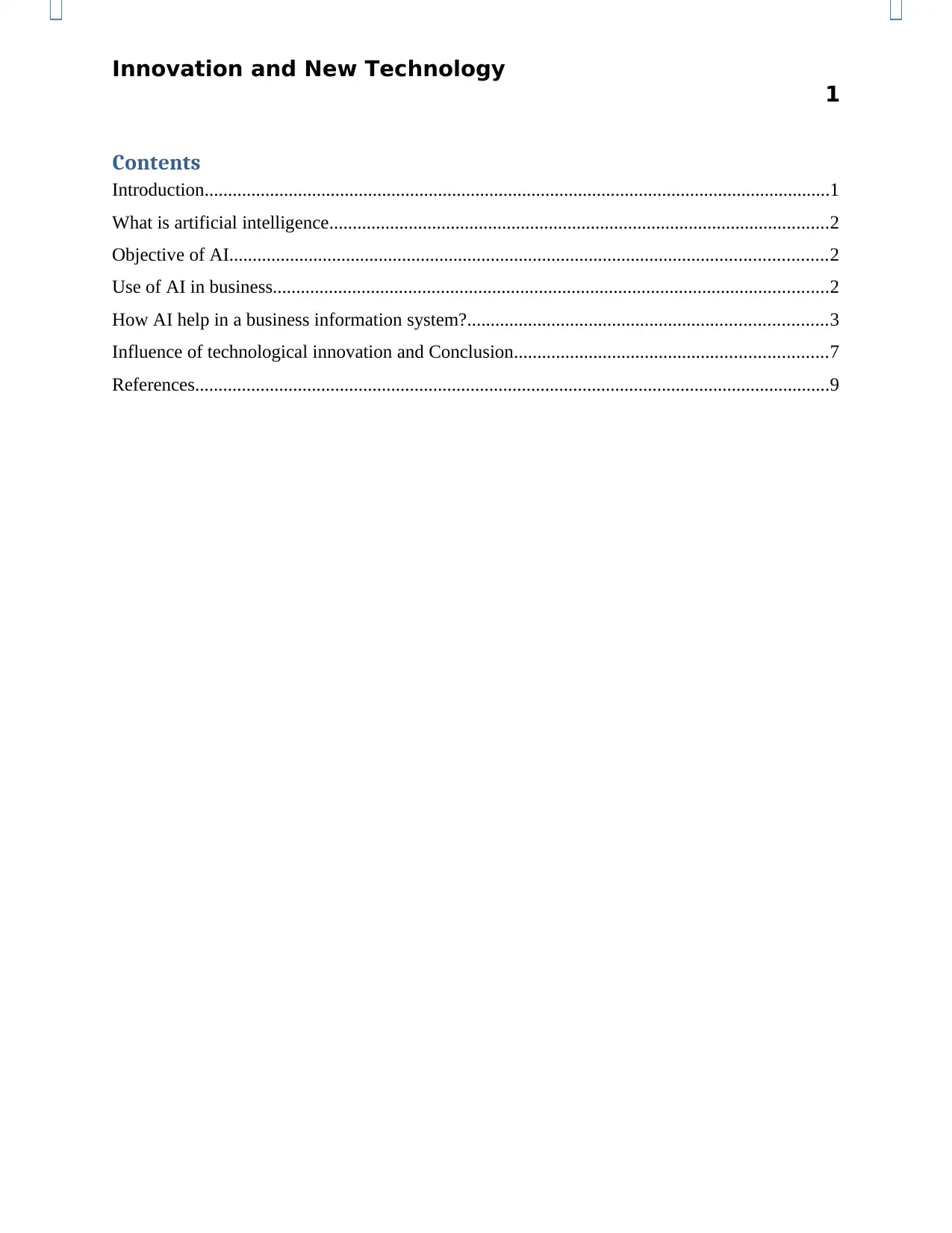
Innovation and New Technology
1
Contents
Introduction......................................................................................................................................1
What is artificial intelligence...........................................................................................................2
Objective of AI................................................................................................................................2
Use of AI in business.......................................................................................................................2
How AI help in a business information system?.............................................................................3
Influence of technological innovation and Conclusion...................................................................7
References........................................................................................................................................9
1
Contents
Introduction......................................................................................................................................1
What is artificial intelligence...........................................................................................................2
Objective of AI................................................................................................................................2
Use of AI in business.......................................................................................................................2
How AI help in a business information system?.............................................................................3
Influence of technological innovation and Conclusion...................................................................7
References........................................................................................................................................9
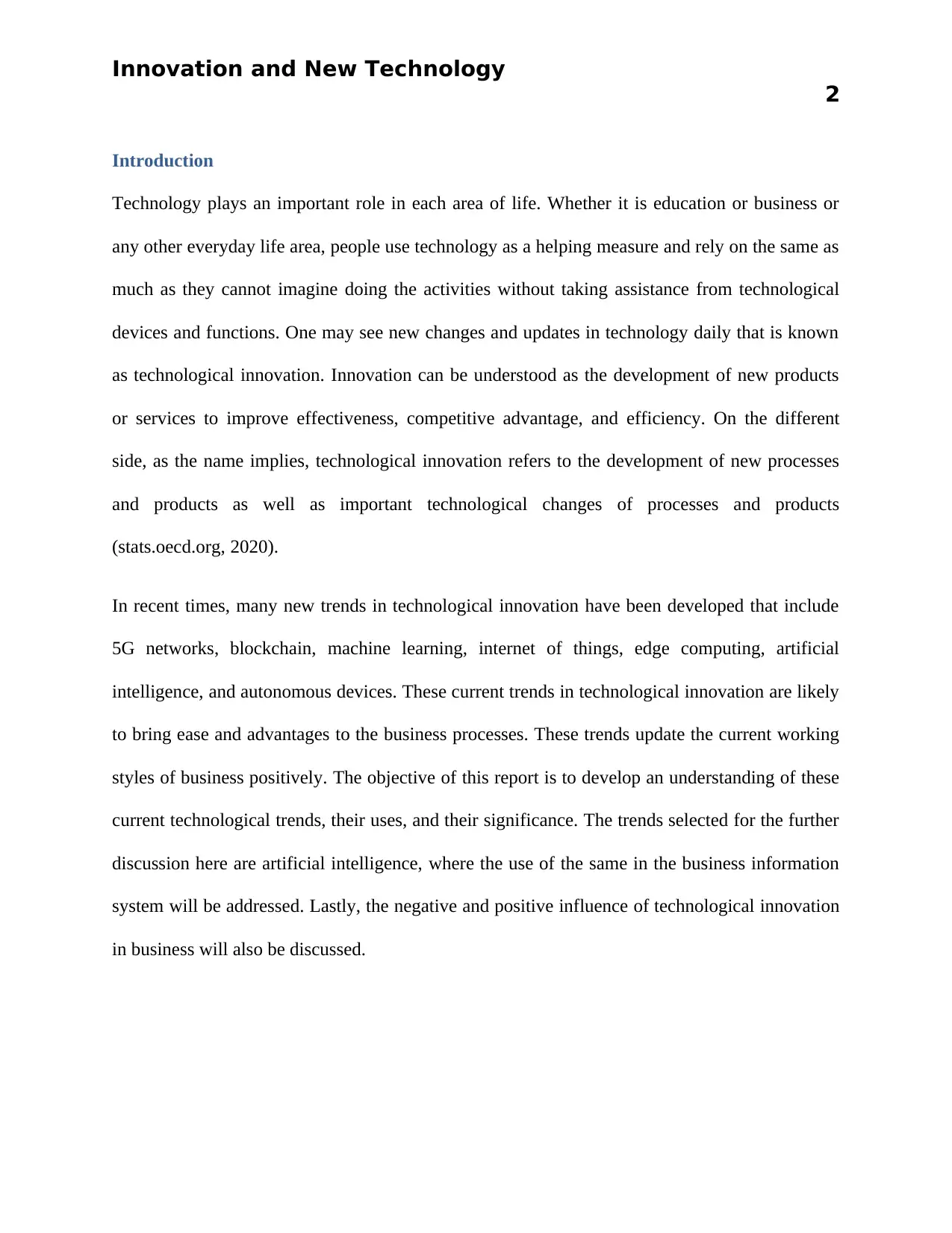
Innovation and New Technology
2
Introduction
Technology plays an important role in each area of life. Whether it is education or business or
any other everyday life area, people use technology as a helping measure and rely on the same as
much as they cannot imagine doing the activities without taking assistance from technological
devices and functions. One may see new changes and updates in technology daily that is known
as technological innovation. Innovation can be understood as the development of new products
or services to improve effectiveness, competitive advantage, and efficiency. On the different
side, as the name implies, technological innovation refers to the development of new processes
and products as well as important technological changes of processes and products
(stats.oecd.org, 2020).
In recent times, many new trends in technological innovation have been developed that include
5G networks, blockchain, machine learning, internet of things, edge computing, artificial
intelligence, and autonomous devices. These current trends in technological innovation are likely
to bring ease and advantages to the business processes. These trends update the current working
styles of business positively. The objective of this report is to develop an understanding of these
current technological trends, their uses, and their significance. The trends selected for the further
discussion here are artificial intelligence, where the use of the same in the business information
system will be addressed. Lastly, the negative and positive influence of technological innovation
in business will also be discussed.
2
Introduction
Technology plays an important role in each area of life. Whether it is education or business or
any other everyday life area, people use technology as a helping measure and rely on the same as
much as they cannot imagine doing the activities without taking assistance from technological
devices and functions. One may see new changes and updates in technology daily that is known
as technological innovation. Innovation can be understood as the development of new products
or services to improve effectiveness, competitive advantage, and efficiency. On the different
side, as the name implies, technological innovation refers to the development of new processes
and products as well as important technological changes of processes and products
(stats.oecd.org, 2020).
In recent times, many new trends in technological innovation have been developed that include
5G networks, blockchain, machine learning, internet of things, edge computing, artificial
intelligence, and autonomous devices. These current trends in technological innovation are likely
to bring ease and advantages to the business processes. These trends update the current working
styles of business positively. The objective of this report is to develop an understanding of these
current technological trends, their uses, and their significance. The trends selected for the further
discussion here are artificial intelligence, where the use of the same in the business information
system will be addressed. Lastly, the negative and positive influence of technological innovation
in business will also be discussed.
⊘ This is a preview!⊘
Do you want full access?
Subscribe today to unlock all pages.

Trusted by 1+ million students worldwide
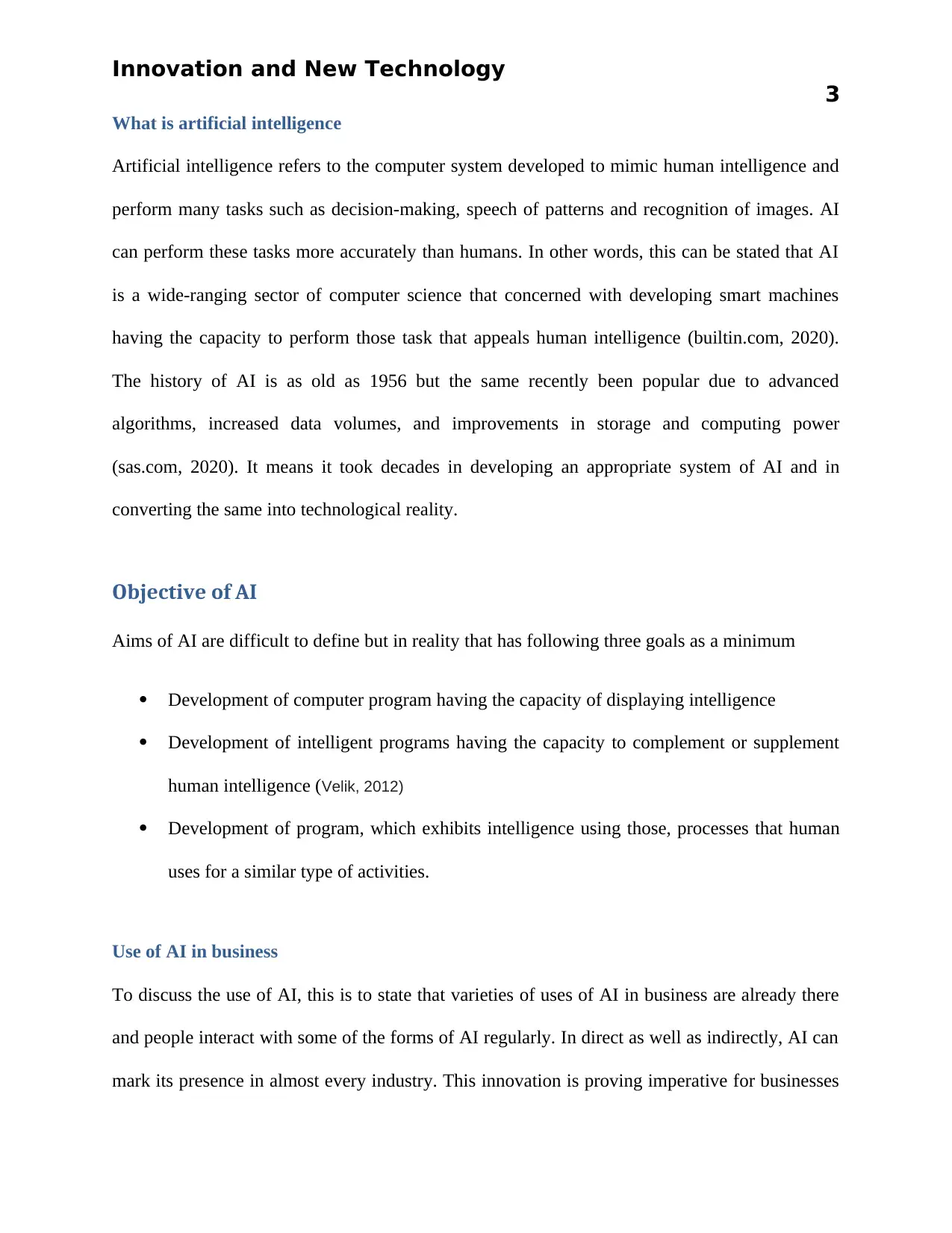
Innovation and New Technology
3
What is artificial intelligence
Artificial intelligence refers to the computer system developed to mimic human intelligence and
perform many tasks such as decision-making, speech of patterns and recognition of images. AI
can perform these tasks more accurately than humans. In other words, this can be stated that AI
is a wide-ranging sector of computer science that concerned with developing smart machines
having the capacity to perform those task that appeals human intelligence (builtin.com, 2020).
The history of AI is as old as 1956 but the same recently been popular due to advanced
algorithms, increased data volumes, and improvements in storage and computing power
(sas.com, 2020). It means it took decades in developing an appropriate system of AI and in
converting the same into technological reality.
Objective of AI
Aims of AI are difficult to define but in reality that has following three goals as a minimum
Development of computer program having the capacity of displaying intelligence
Development of intelligent programs having the capacity to complement or supplement
human intelligence (Velik, 2012)
Development of program, which exhibits intelligence using those, processes that human
uses for a similar type of activities.
Use of AI in business
To discuss the use of AI, this is to state that varieties of uses of AI in business are already there
and people interact with some of the forms of AI regularly. In direct as well as indirectly, AI can
mark its presence in almost every industry. This innovation is proving imperative for businesses
3
What is artificial intelligence
Artificial intelligence refers to the computer system developed to mimic human intelligence and
perform many tasks such as decision-making, speech of patterns and recognition of images. AI
can perform these tasks more accurately than humans. In other words, this can be stated that AI
is a wide-ranging sector of computer science that concerned with developing smart machines
having the capacity to perform those task that appeals human intelligence (builtin.com, 2020).
The history of AI is as old as 1956 but the same recently been popular due to advanced
algorithms, increased data volumes, and improvements in storage and computing power
(sas.com, 2020). It means it took decades in developing an appropriate system of AI and in
converting the same into technological reality.
Objective of AI
Aims of AI are difficult to define but in reality that has following three goals as a minimum
Development of computer program having the capacity of displaying intelligence
Development of intelligent programs having the capacity to complement or supplement
human intelligence (Velik, 2012)
Development of program, which exhibits intelligence using those, processes that human
uses for a similar type of activities.
Use of AI in business
To discuss the use of AI, this is to state that varieties of uses of AI in business are already there
and people interact with some of the forms of AI regularly. In direct as well as indirectly, AI can
mark its presence in almost every industry. This innovation is proving imperative for businesses
Paraphrase This Document
Need a fresh take? Get an instant paraphrase of this document with our AI Paraphraser
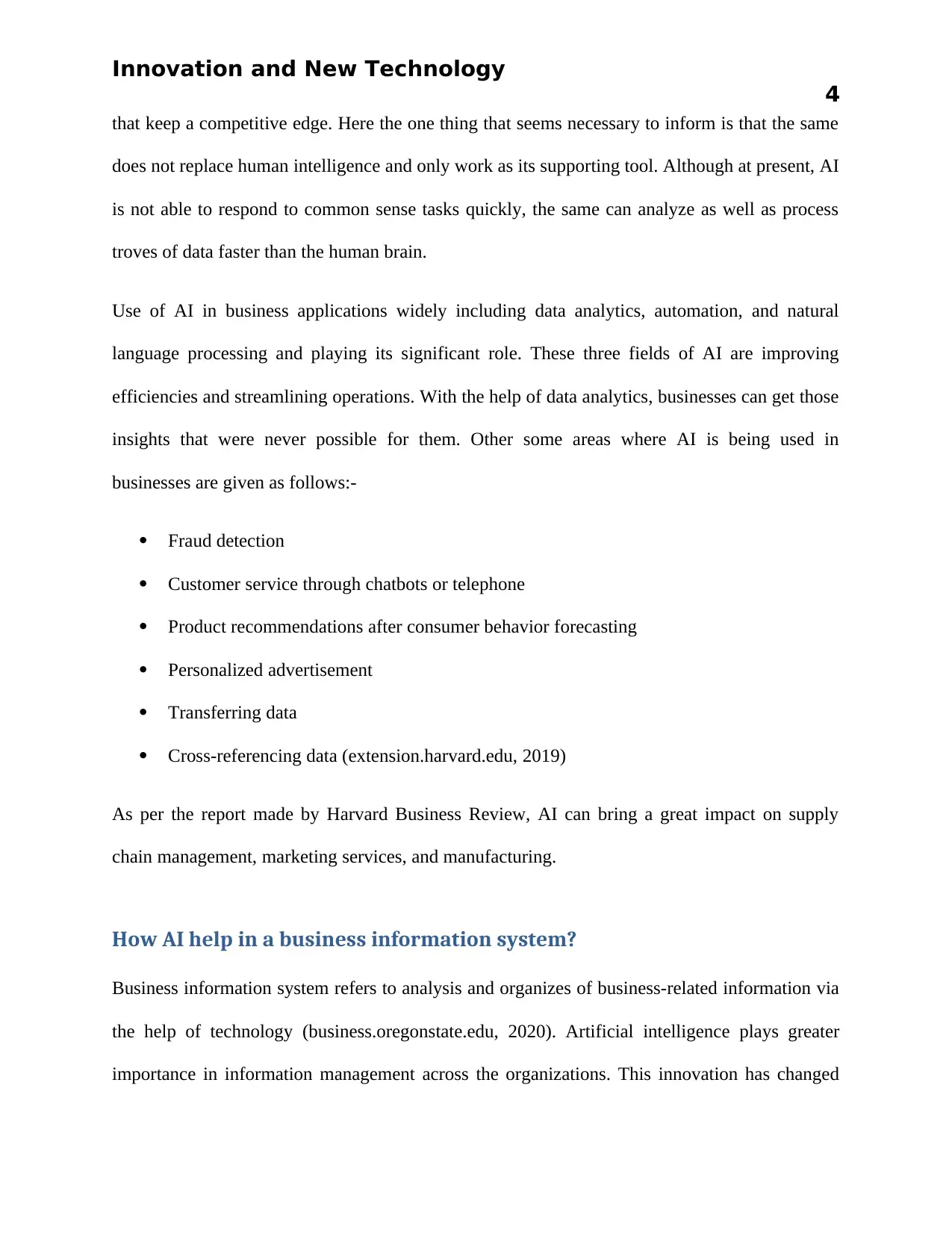
Innovation and New Technology
4
that keep a competitive edge. Here the one thing that seems necessary to inform is that the same
does not replace human intelligence and only work as its supporting tool. Although at present, AI
is not able to respond to common sense tasks quickly, the same can analyze as well as process
troves of data faster than the human brain.
Use of AI in business applications widely including data analytics, automation, and natural
language processing and playing its significant role. These three fields of AI are improving
efficiencies and streamlining operations. With the help of data analytics, businesses can get those
insights that were never possible for them. Other some areas where AI is being used in
businesses are given as follows:-
Fraud detection
Customer service through chatbots or telephone
Product recommendations after consumer behavior forecasting
Personalized advertisement
Transferring data
Cross-referencing data (extension.harvard.edu, 2019)
As per the report made by Harvard Business Review, AI can bring a great impact on supply
chain management, marketing services, and manufacturing.
How AI help in a business information system?
Business information system refers to analysis and organizes of business-related information via
the help of technology (business.oregonstate.edu, 2020). Artificial intelligence plays greater
importance in information management across the organizations. This innovation has changed
4
that keep a competitive edge. Here the one thing that seems necessary to inform is that the same
does not replace human intelligence and only work as its supporting tool. Although at present, AI
is not able to respond to common sense tasks quickly, the same can analyze as well as process
troves of data faster than the human brain.
Use of AI in business applications widely including data analytics, automation, and natural
language processing and playing its significant role. These three fields of AI are improving
efficiencies and streamlining operations. With the help of data analytics, businesses can get those
insights that were never possible for them. Other some areas where AI is being used in
businesses are given as follows:-
Fraud detection
Customer service through chatbots or telephone
Product recommendations after consumer behavior forecasting
Personalized advertisement
Transferring data
Cross-referencing data (extension.harvard.edu, 2019)
As per the report made by Harvard Business Review, AI can bring a great impact on supply
chain management, marketing services, and manufacturing.
How AI help in a business information system?
Business information system refers to analysis and organizes of business-related information via
the help of technology (business.oregonstate.edu, 2020). Artificial intelligence plays greater
importance in information management across the organizations. This innovation has changed
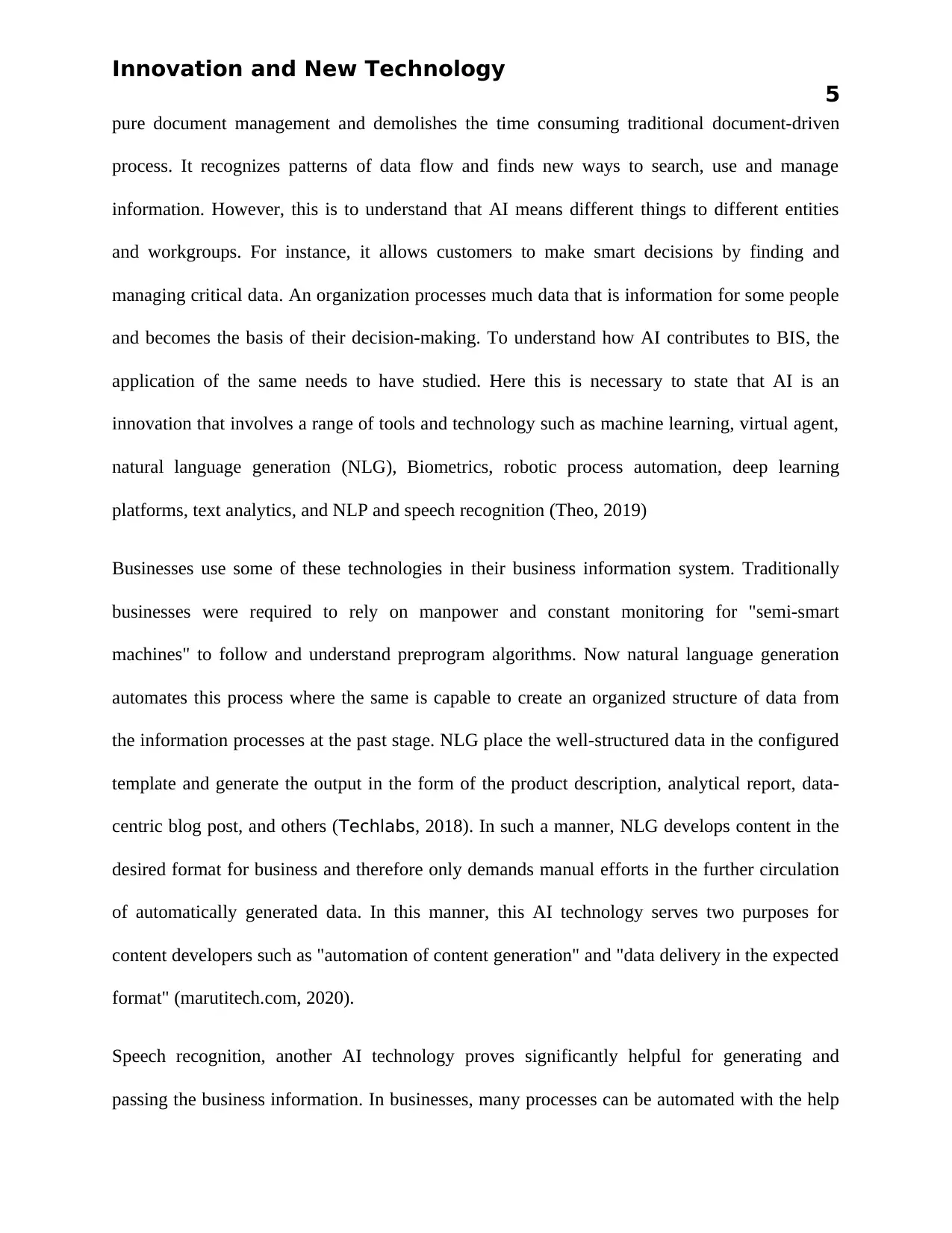
Innovation and New Technology
5
pure document management and demolishes the time consuming traditional document-driven
process. It recognizes patterns of data flow and finds new ways to search, use and manage
information. However, this is to understand that AI means different things to different entities
and workgroups. For instance, it allows customers to make smart decisions by finding and
managing critical data. An organization processes much data that is information for some people
and becomes the basis of their decision-making. To understand how AI contributes to BIS, the
application of the same needs to have studied. Here this is necessary to state that AI is an
innovation that involves a range of tools and technology such as machine learning, virtual agent,
natural language generation (NLG), Biometrics, robotic process automation, deep learning
platforms, text analytics, and NLP and speech recognition (Theo, 2019)
Businesses use some of these technologies in their business information system. Traditionally
businesses were required to rely on manpower and constant monitoring for "semi-smart
machines" to follow and understand preprogram algorithms. Now natural language generation
automates this process where the same is capable to create an organized structure of data from
the information processes at the past stage. NLG place the well-structured data in the configured
template and generate the output in the form of the product description, analytical report, data-
centric blog post, and others (Techlabs, 2018). In such a manner, NLG develops content in the
desired format for business and therefore only demands manual efforts in the further circulation
of automatically generated data. In this manner, this AI technology serves two purposes for
content developers such as "automation of content generation" and "data delivery in the expected
format" (marutitech.com, 2020).
Speech recognition, another AI technology proves significantly helpful for generating and
passing the business information. In businesses, many processes can be automated with the help
5
pure document management and demolishes the time consuming traditional document-driven
process. It recognizes patterns of data flow and finds new ways to search, use and manage
information. However, this is to understand that AI means different things to different entities
and workgroups. For instance, it allows customers to make smart decisions by finding and
managing critical data. An organization processes much data that is information for some people
and becomes the basis of their decision-making. To understand how AI contributes to BIS, the
application of the same needs to have studied. Here this is necessary to state that AI is an
innovation that involves a range of tools and technology such as machine learning, virtual agent,
natural language generation (NLG), Biometrics, robotic process automation, deep learning
platforms, text analytics, and NLP and speech recognition (Theo, 2019)
Businesses use some of these technologies in their business information system. Traditionally
businesses were required to rely on manpower and constant monitoring for "semi-smart
machines" to follow and understand preprogram algorithms. Now natural language generation
automates this process where the same is capable to create an organized structure of data from
the information processes at the past stage. NLG place the well-structured data in the configured
template and generate the output in the form of the product description, analytical report, data-
centric blog post, and others (Techlabs, 2018). In such a manner, NLG develops content in the
desired format for business and therefore only demands manual efforts in the further circulation
of automatically generated data. In this manner, this AI technology serves two purposes for
content developers such as "automation of content generation" and "data delivery in the expected
format" (marutitech.com, 2020).
Speech recognition, another AI technology proves significantly helpful for generating and
passing the business information. In businesses, many processes can be automated with the help
⊘ This is a preview!⊘
Do you want full access?
Subscribe today to unlock all pages.

Trusted by 1+ million students worldwide
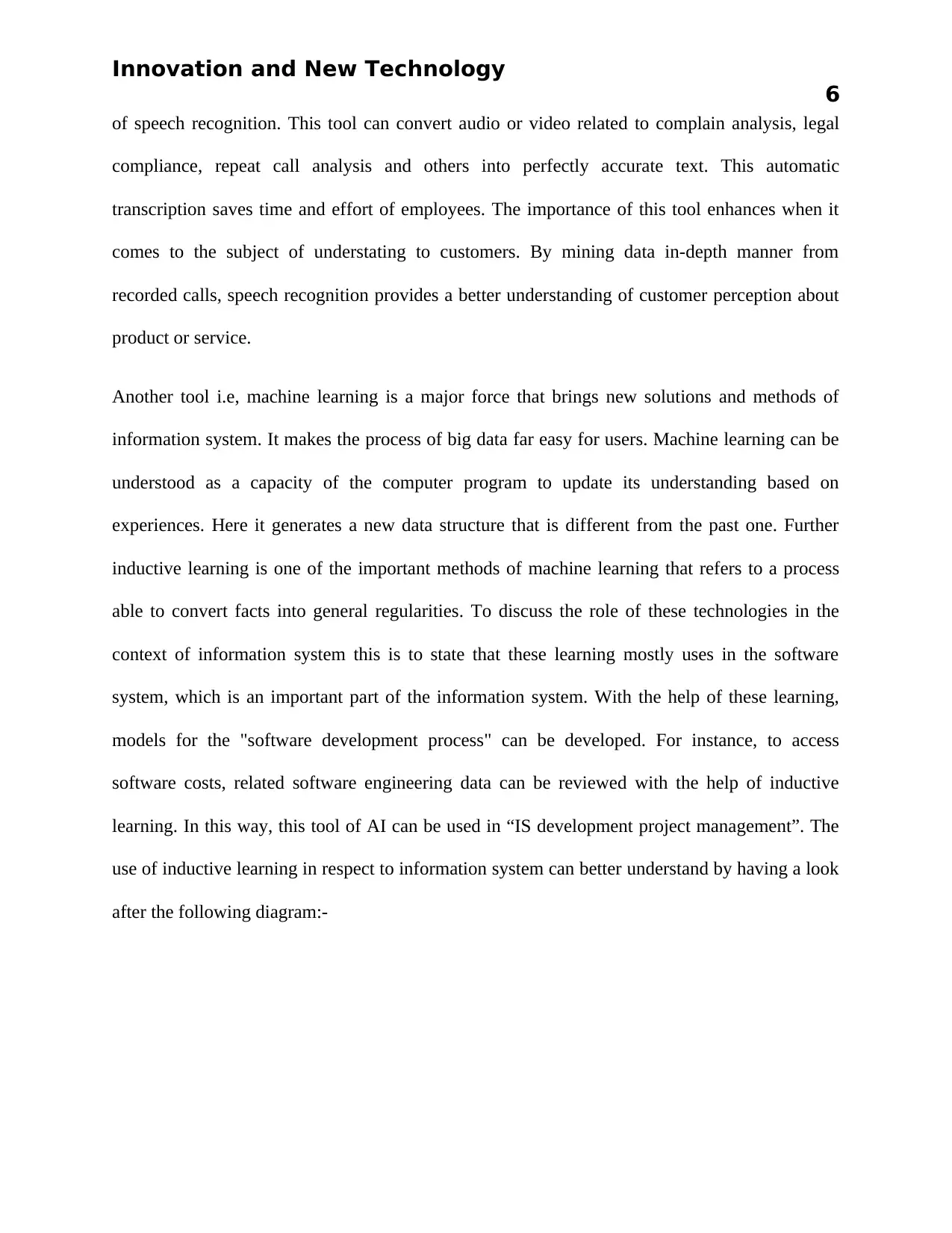
Innovation and New Technology
6
of speech recognition. This tool can convert audio or video related to complain analysis, legal
compliance, repeat call analysis and others into perfectly accurate text. This automatic
transcription saves time and effort of employees. The importance of this tool enhances when it
comes to the subject of understating to customers. By mining data in-depth manner from
recorded calls, speech recognition provides a better understanding of customer perception about
product or service.
Another tool i.e, machine learning is a major force that brings new solutions and methods of
information system. It makes the process of big data far easy for users. Machine learning can be
understood as a capacity of the computer program to update its understanding based on
experiences. Here it generates a new data structure that is different from the past one. Further
inductive learning is one of the important methods of machine learning that refers to a process
able to convert facts into general regularities. To discuss the role of these technologies in the
context of information system this is to state that these learning mostly uses in the software
system, which is an important part of the information system. With the help of these learning,
models for the "software development process" can be developed. For instance, to access
software costs, related software engineering data can be reviewed with the help of inductive
learning. In this way, this tool of AI can be used in “IS development project management”. The
use of inductive learning in respect to information system can better understand by having a look
after the following diagram:-
6
of speech recognition. This tool can convert audio or video related to complain analysis, legal
compliance, repeat call analysis and others into perfectly accurate text. This automatic
transcription saves time and effort of employees. The importance of this tool enhances when it
comes to the subject of understating to customers. By mining data in-depth manner from
recorded calls, speech recognition provides a better understanding of customer perception about
product or service.
Another tool i.e, machine learning is a major force that brings new solutions and methods of
information system. It makes the process of big data far easy for users. Machine learning can be
understood as a capacity of the computer program to update its understanding based on
experiences. Here it generates a new data structure that is different from the past one. Further
inductive learning is one of the important methods of machine learning that refers to a process
able to convert facts into general regularities. To discuss the role of these technologies in the
context of information system this is to state that these learning mostly uses in the software
system, which is an important part of the information system. With the help of these learning,
models for the "software development process" can be developed. For instance, to access
software costs, related software engineering data can be reviewed with the help of inductive
learning. In this way, this tool of AI can be used in “IS development project management”. The
use of inductive learning in respect to information system can better understand by having a look
after the following diagram:-
Paraphrase This Document
Need a fresh take? Get an instant paraphrase of this document with our AI Paraphraser
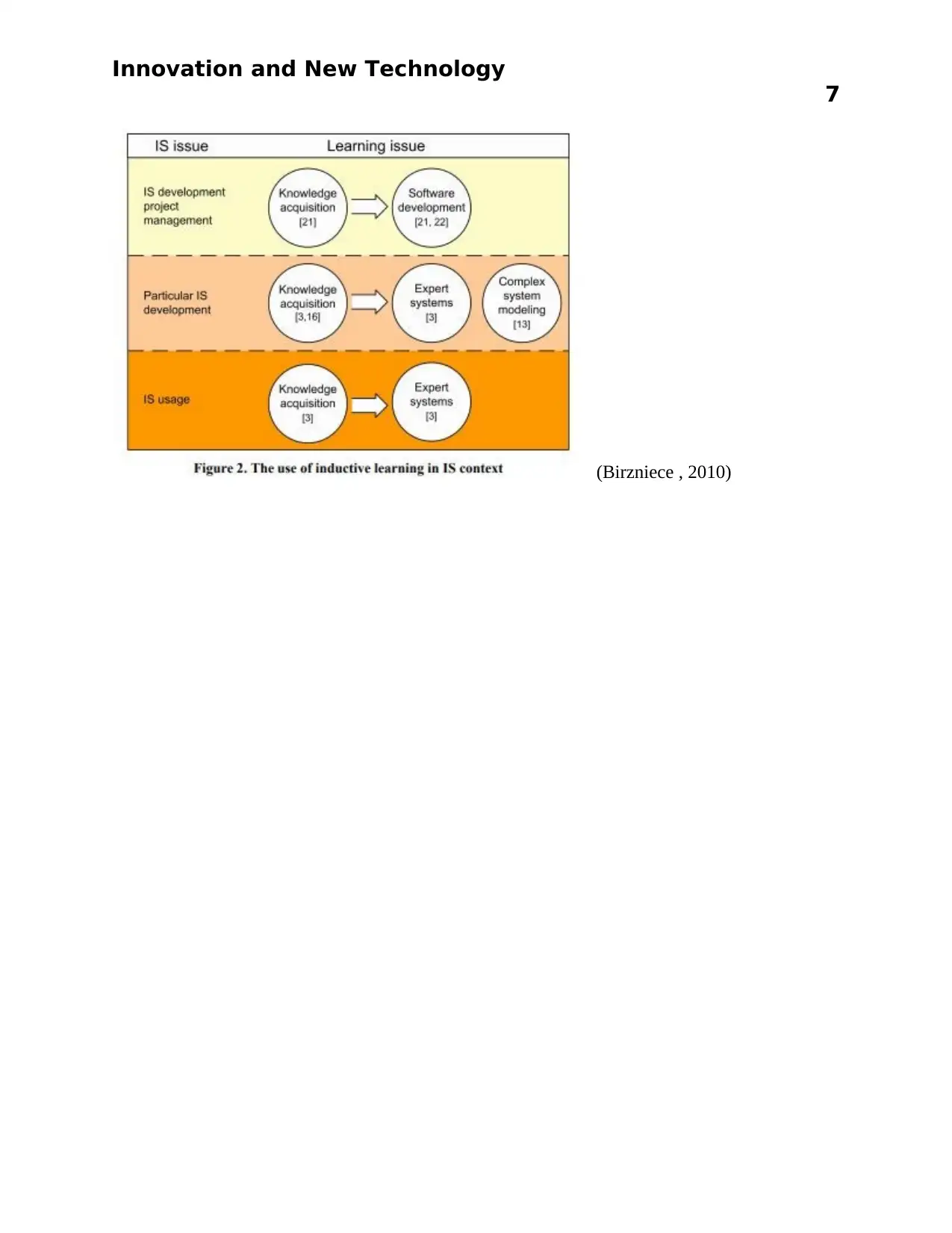
Innovation and New Technology
7
(Birzniece , 2010)
7
(Birzniece , 2010)
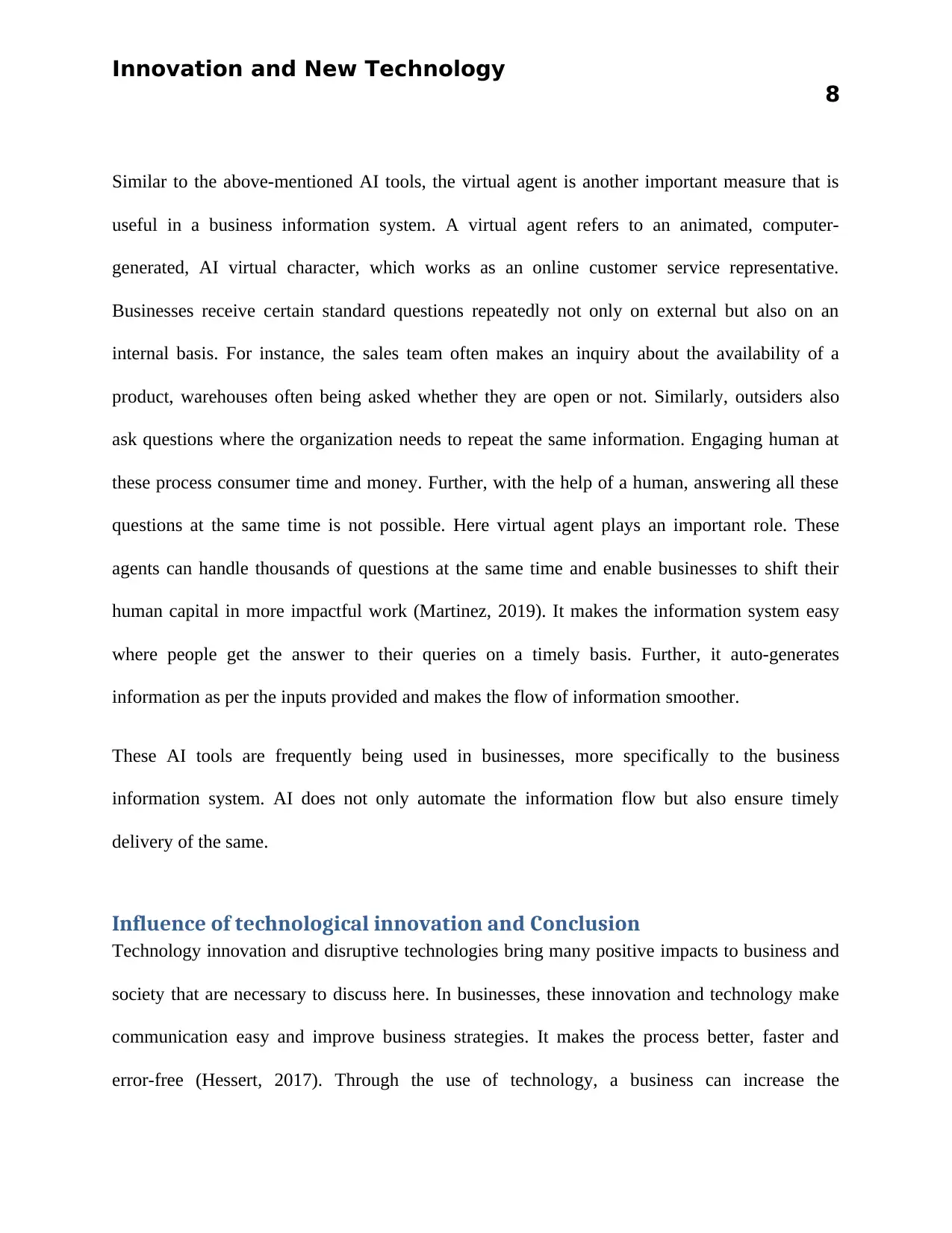
Innovation and New Technology
8
Similar to the above-mentioned AI tools, the virtual agent is another important measure that is
useful in a business information system. A virtual agent refers to an animated, computer-
generated, AI virtual character, which works as an online customer service representative.
Businesses receive certain standard questions repeatedly not only on external but also on an
internal basis. For instance, the sales team often makes an inquiry about the availability of a
product, warehouses often being asked whether they are open or not. Similarly, outsiders also
ask questions where the organization needs to repeat the same information. Engaging human at
these process consumer time and money. Further, with the help of a human, answering all these
questions at the same time is not possible. Here virtual agent plays an important role. These
agents can handle thousands of questions at the same time and enable businesses to shift their
human capital in more impactful work (Martinez, 2019). It makes the information system easy
where people get the answer to their queries on a timely basis. Further, it auto-generates
information as per the inputs provided and makes the flow of information smoother.
These AI tools are frequently being used in businesses, more specifically to the business
information system. AI does not only automate the information flow but also ensure timely
delivery of the same.
Influence of technological innovation and Conclusion
Technology innovation and disruptive technologies bring many positive impacts to business and
society that are necessary to discuss here. In businesses, these innovation and technology make
communication easy and improve business strategies. It makes the process better, faster and
error-free (Hessert, 2017). Through the use of technology, a business can increase the
8
Similar to the above-mentioned AI tools, the virtual agent is another important measure that is
useful in a business information system. A virtual agent refers to an animated, computer-
generated, AI virtual character, which works as an online customer service representative.
Businesses receive certain standard questions repeatedly not only on external but also on an
internal basis. For instance, the sales team often makes an inquiry about the availability of a
product, warehouses often being asked whether they are open or not. Similarly, outsiders also
ask questions where the organization needs to repeat the same information. Engaging human at
these process consumer time and money. Further, with the help of a human, answering all these
questions at the same time is not possible. Here virtual agent plays an important role. These
agents can handle thousands of questions at the same time and enable businesses to shift their
human capital in more impactful work (Martinez, 2019). It makes the information system easy
where people get the answer to their queries on a timely basis. Further, it auto-generates
information as per the inputs provided and makes the flow of information smoother.
These AI tools are frequently being used in businesses, more specifically to the business
information system. AI does not only automate the information flow but also ensure timely
delivery of the same.
Influence of technological innovation and Conclusion
Technology innovation and disruptive technologies bring many positive impacts to business and
society that are necessary to discuss here. In businesses, these innovation and technology make
communication easy and improve business strategies. It makes the process better, faster and
error-free (Hessert, 2017). Through the use of technology, a business can increase the
⊘ This is a preview!⊘
Do you want full access?
Subscribe today to unlock all pages.

Trusted by 1+ million students worldwide
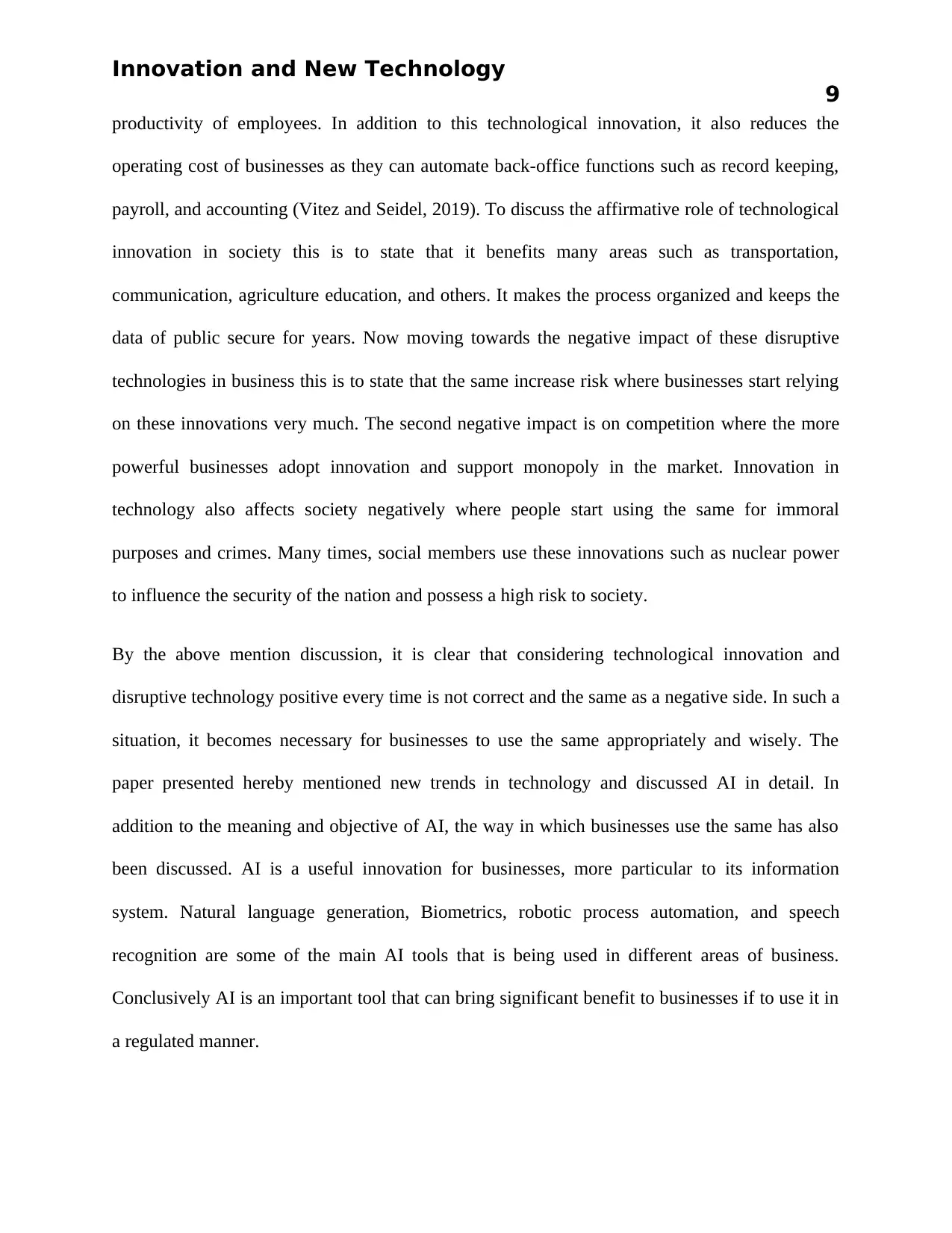
Innovation and New Technology
9
productivity of employees. In addition to this technological innovation, it also reduces the
operating cost of businesses as they can automate back-office functions such as record keeping,
payroll, and accounting (Vitez and Seidel, 2019). To discuss the affirmative role of technological
innovation in society this is to state that it benefits many areas such as transportation,
communication, agriculture education, and others. It makes the process organized and keeps the
data of public secure for years. Now moving towards the negative impact of these disruptive
technologies in business this is to state that the same increase risk where businesses start relying
on these innovations very much. The second negative impact is on competition where the more
powerful businesses adopt innovation and support monopoly in the market. Innovation in
technology also affects society negatively where people start using the same for immoral
purposes and crimes. Many times, social members use these innovations such as nuclear power
to influence the security of the nation and possess a high risk to society.
By the above mention discussion, it is clear that considering technological innovation and
disruptive technology positive every time is not correct and the same as a negative side. In such a
situation, it becomes necessary for businesses to use the same appropriately and wisely. The
paper presented hereby mentioned new trends in technology and discussed AI in detail. In
addition to the meaning and objective of AI, the way in which businesses use the same has also
been discussed. AI is a useful innovation for businesses, more particular to its information
system. Natural language generation, Biometrics, robotic process automation, and speech
recognition are some of the main AI tools that is being used in different areas of business.
Conclusively AI is an important tool that can bring significant benefit to businesses if to use it in
a regulated manner.
9
productivity of employees. In addition to this technological innovation, it also reduces the
operating cost of businesses as they can automate back-office functions such as record keeping,
payroll, and accounting (Vitez and Seidel, 2019). To discuss the affirmative role of technological
innovation in society this is to state that it benefits many areas such as transportation,
communication, agriculture education, and others. It makes the process organized and keeps the
data of public secure for years. Now moving towards the negative impact of these disruptive
technologies in business this is to state that the same increase risk where businesses start relying
on these innovations very much. The second negative impact is on competition where the more
powerful businesses adopt innovation and support monopoly in the market. Innovation in
technology also affects society negatively where people start using the same for immoral
purposes and crimes. Many times, social members use these innovations such as nuclear power
to influence the security of the nation and possess a high risk to society.
By the above mention discussion, it is clear that considering technological innovation and
disruptive technology positive every time is not correct and the same as a negative side. In such a
situation, it becomes necessary for businesses to use the same appropriately and wisely. The
paper presented hereby mentioned new trends in technology and discussed AI in detail. In
addition to the meaning and objective of AI, the way in which businesses use the same has also
been discussed. AI is a useful innovation for businesses, more particular to its information
system. Natural language generation, Biometrics, robotic process automation, and speech
recognition are some of the main AI tools that is being used in different areas of business.
Conclusively AI is an important tool that can bring significant benefit to businesses if to use it in
a regulated manner.
Paraphrase This Document
Need a fresh take? Get an instant paraphrase of this document with our AI Paraphraser
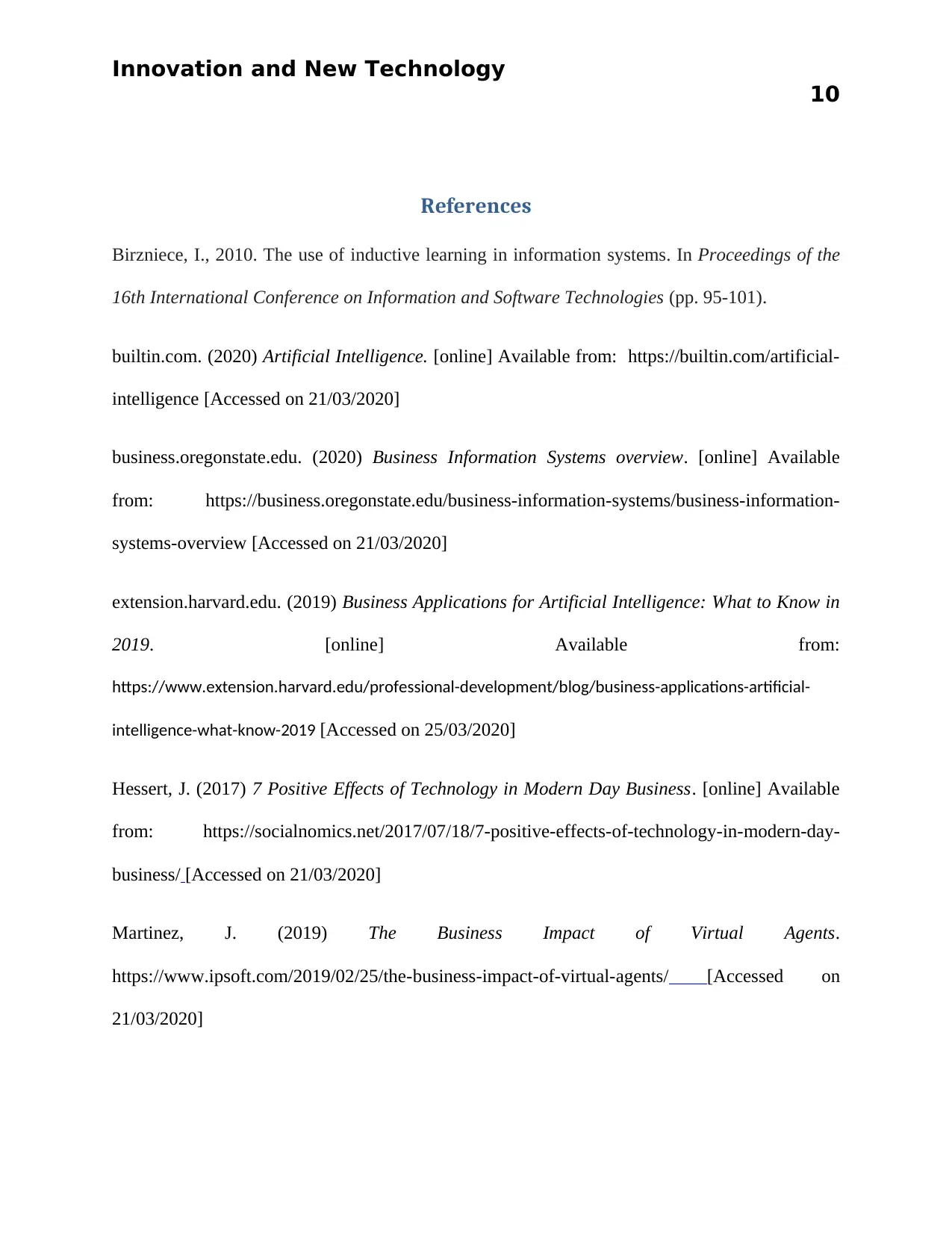
Innovation and New Technology
10
References
Birzniece, I., 2010. The use of inductive learning in information systems. In Proceedings of the
16th International Conference on Information and Software Technologies (pp. 95-101).
builtin.com. (2020) Artificial Intelligence. [online] Available from: https://builtin.com/artificial-
intelligence [Accessed on 21/03/2020]
business.oregonstate.edu. (2020) Business Information Systems overview. [online] Available
from: https://business.oregonstate.edu/business-information-systems/business-information-
systems-overview [Accessed on 21/03/2020]
extension.harvard.edu. (2019) Business Applications for Artificial Intelligence: What to Know in
2019. [online] Available from:
https://www.extension.harvard.edu/professional-development/blog/business-applications-artificial-
intelligence-what-know-2019 [Accessed on 25/03/2020]
Hessert, J. (2017) 7 Positive Effects of Technology in Modern Day Business. [online] Available
from: https://socialnomics.net/2017/07/18/7-positive-effects-of-technology-in-modern-day-
business/ [Accessed on 21/03/2020]
Martinez, J. (2019) The Business Impact of Virtual Agents.
https://www.ipsoft.com/2019/02/25/the-business-impact-of-virtual-agents/ [Accessed on
21/03/2020]
10
References
Birzniece, I., 2010. The use of inductive learning in information systems. In Proceedings of the
16th International Conference on Information and Software Technologies (pp. 95-101).
builtin.com. (2020) Artificial Intelligence. [online] Available from: https://builtin.com/artificial-
intelligence [Accessed on 21/03/2020]
business.oregonstate.edu. (2020) Business Information Systems overview. [online] Available
from: https://business.oregonstate.edu/business-information-systems/business-information-
systems-overview [Accessed on 21/03/2020]
extension.harvard.edu. (2019) Business Applications for Artificial Intelligence: What to Know in
2019. [online] Available from:
https://www.extension.harvard.edu/professional-development/blog/business-applications-artificial-
intelligence-what-know-2019 [Accessed on 25/03/2020]
Hessert, J. (2017) 7 Positive Effects of Technology in Modern Day Business. [online] Available
from: https://socialnomics.net/2017/07/18/7-positive-effects-of-technology-in-modern-day-
business/ [Accessed on 21/03/2020]
Martinez, J. (2019) The Business Impact of Virtual Agents.
https://www.ipsoft.com/2019/02/25/the-business-impact-of-virtual-agents/ [Accessed on
21/03/2020]
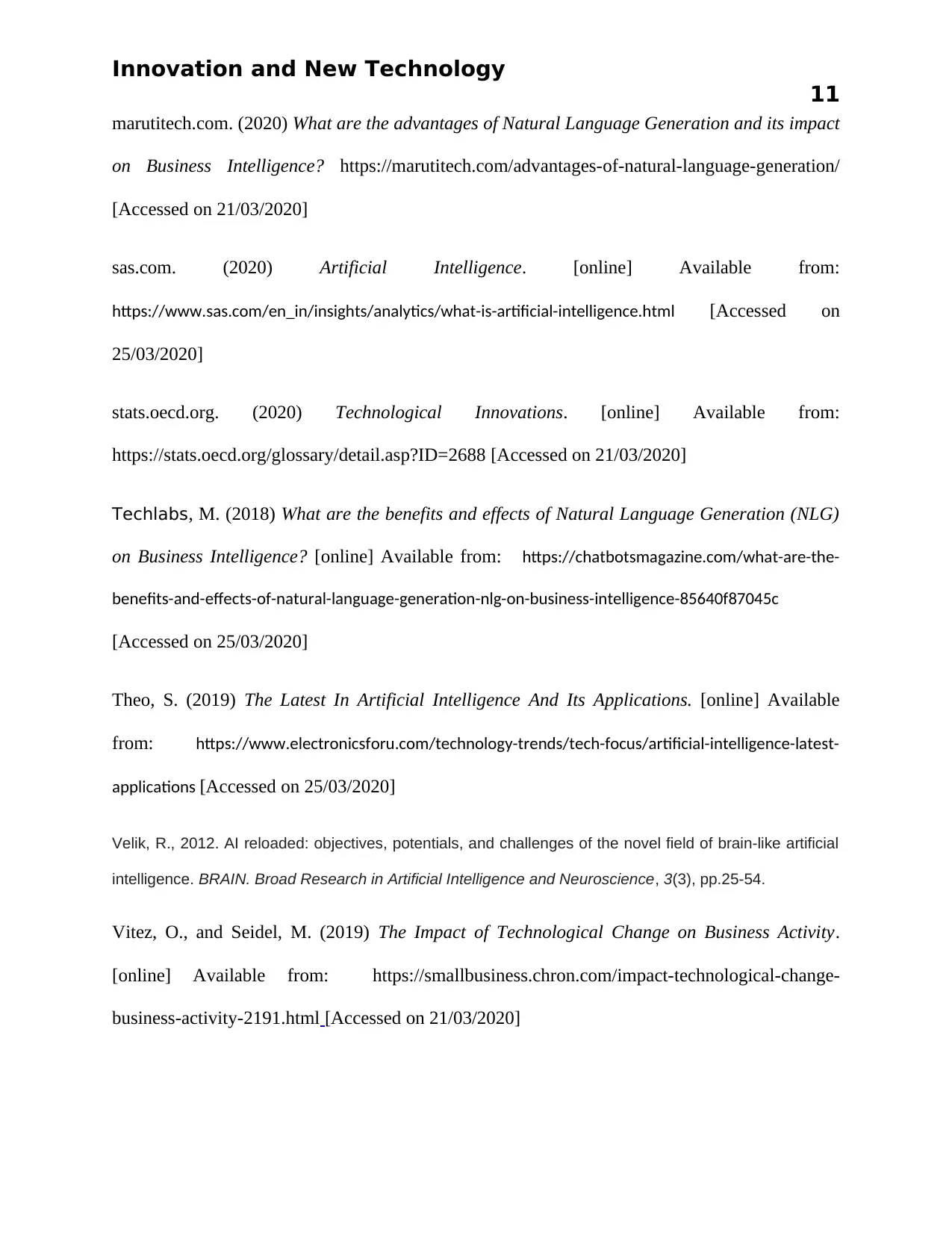
Innovation and New Technology
11
marutitech.com. (2020) What are the advantages of Natural Language Generation and its impact
on Business Intelligence? https://marutitech.com/advantages-of-natural-language-generation/
[Accessed on 21/03/2020]
sas.com. (2020) Artificial Intelligence. [online] Available from:
https://www.sas.com/en_in/insights/analytics/what-is-artificial-intelligence.html [Accessed on
25/03/2020]
stats.oecd.org. (2020) Technological Innovations. [online] Available from:
https://stats.oecd.org/glossary/detail.asp?ID=2688 [Accessed on 21/03/2020]
Techlabs, M. (2018) What are the benefits and effects of Natural Language Generation (NLG)
on Business Intelligence? [online] Available from: https://chatbotsmagazine.com/what-are-the-
benefits-and-effects-of-natural-language-generation-nlg-on-business-intelligence-85640f87045c
[Accessed on 25/03/2020]
Theo, S. (2019) The Latest In Artificial Intelligence And Its Applications. [online] Available
from: https://www.electronicsforu.com/technology-trends/tech-focus/artificial-intelligence-latest-
applications [Accessed on 25/03/2020]
Velik, R., 2012. AI reloaded: objectives, potentials, and challenges of the novel field of brain-like artificial
intelligence. BRAIN. Broad Research in Artificial Intelligence and Neuroscience, 3(3), pp.25-54.
Vitez, O., and Seidel, M. (2019) The Impact of Technological Change on Business Activity.
[online] Available from: https://smallbusiness.chron.com/impact-technological-change-
business-activity-2191.html [Accessed on 21/03/2020]
11
marutitech.com. (2020) What are the advantages of Natural Language Generation and its impact
on Business Intelligence? https://marutitech.com/advantages-of-natural-language-generation/
[Accessed on 21/03/2020]
sas.com. (2020) Artificial Intelligence. [online] Available from:
https://www.sas.com/en_in/insights/analytics/what-is-artificial-intelligence.html [Accessed on
25/03/2020]
stats.oecd.org. (2020) Technological Innovations. [online] Available from:
https://stats.oecd.org/glossary/detail.asp?ID=2688 [Accessed on 21/03/2020]
Techlabs, M. (2018) What are the benefits and effects of Natural Language Generation (NLG)
on Business Intelligence? [online] Available from: https://chatbotsmagazine.com/what-are-the-
benefits-and-effects-of-natural-language-generation-nlg-on-business-intelligence-85640f87045c
[Accessed on 25/03/2020]
Theo, S. (2019) The Latest In Artificial Intelligence And Its Applications. [online] Available
from: https://www.electronicsforu.com/technology-trends/tech-focus/artificial-intelligence-latest-
applications [Accessed on 25/03/2020]
Velik, R., 2012. AI reloaded: objectives, potentials, and challenges of the novel field of brain-like artificial
intelligence. BRAIN. Broad Research in Artificial Intelligence and Neuroscience, 3(3), pp.25-54.
Vitez, O., and Seidel, M. (2019) The Impact of Technological Change on Business Activity.
[online] Available from: https://smallbusiness.chron.com/impact-technological-change-
business-activity-2191.html [Accessed on 21/03/2020]
⊘ This is a preview!⊘
Do you want full access?
Subscribe today to unlock all pages.

Trusted by 1+ million students worldwide
1 out of 12
Related Documents
Your All-in-One AI-Powered Toolkit for Academic Success.
+13062052269
info@desklib.com
Available 24*7 on WhatsApp / Email
![[object Object]](/_next/static/media/star-bottom.7253800d.svg)
Unlock your academic potential
Copyright © 2020–2025 A2Z Services. All Rights Reserved. Developed and managed by ZUCOL.





